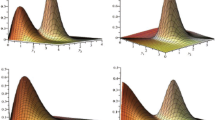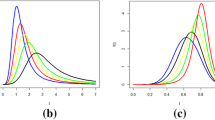Abstract
In this article, several approaches are advanced towards the construction of bivariate Weibull models from the consideration of failure behaviors of the components of a two-component system. First, a general method of construction of bivariate life models is developed in the setting of random environmental effects. Some new bivariate Weibull models are derived as special cases and added insights are provided for some of the existing ones. In the course of model formulation in terms of the dependence structure, a new bivariate family of life distributions is constructed so as to incorporate both positive and negative quadrant dependence in the same parametric setting, and a bivariate Weibull model is obtained as a special case. Finally, some distributional properties are presented for a bivariate Weibull model derived from the consideration of random hazards.
Similar content being viewed by others
References
Basu, A. P. (1988). Multivariate exponential distribution and their applications in reliability, Handbook of Statistics, 7, Quality Control and Reliability, (eds. P. R.Krishnaiah and C. R.Rao), Elsevier, The Netherlands.
Block, H. W. and Basu, A. P. (1974) A continuous bivariate exponential extension, J. Amer. Statist. Assoc., 69, 1031–1037.
Cantor, A. B. and Knapp, R. G. (1985). A test of the equality of survival distributions based on palred observations from conditionally independent exponential distributions, IEEE Trans. Reliability, 34, 342–346.
Clayton, D. G. (1978). A model for association in bivariate life tables and its application in epidemiological studies of familial tendency in chronic disease incidence, Biometrika, 65, 141–151.
Downton, F. (1970). Bivariate exponential distributions in reliability theory, J. Roy. Statist. Soc. Ser. B, 32, 408–417.
Esary, J. D. and Proschan, F. (1970). A reliability bound for systems of maintained, interdependent components, J. Amer. Statist. Assoc., 65, 329–338.
Freund, J. E. (1961). A bivariate extension of exponential distribution, J. Amer. Statist. Assoc., 56, 971–977.
Gumbel, E. J. (1960). Bivariate exponential distribution, J. Amer. Statist. Assoc., 55, 698–707.
Hawkes, A. G. (1972). A bivariate exponential distribution with application to reliability, J. Roy. Statist. Soc. Ser. B, 34, 129–131.
Hougaard, P. (1984). Life table methods for heterogeneous populations: Distributions describing the heterogeneity, Biometrika, 71, 75–83.
Hougaard, P. (1986). A class of multivariate failure time distributions, Biometrika, 73, 671–678.
Johnson, N. L. and Kotz, S. (1972). Distributions in Statistics: Continuous Multivariate Distributions, Wiley, New York.
Kimeldorf, G. and Sampson, A. (1975). One-parameter families of bivariate distributions with fixed marginals, Comm. Statist. A—Theory Methods, 4, 293–301.
Lee, L. (1979). Multivariate distributions having Weibull properties, J. Multivariate Anal., 9, 267–277.
Lehmann, E. L. (1966). Some concepts of dependence, Ann. Math. Statist., 37, 1137–1153.
Lu, J. C. and Bhattacharyya, G. K. (1988a). Some bivariate extensions of the Weibull distribution. Tech. Report No. 821, Department of Statistics, University of Wisconsin, Madison.
Lu, J. C. and Bhattacharyya, G. K. (1988b). Inference procedures for a bivariate exponentia model of Gumbel, Tech. Report No. 838, Department of Statistics, University of Wisconsin, Madison.
Marshall, A. W. and Olkin, I. (1967). A multivariate exponential distribution, J. Amer. Statist. Assoc., 62, 30–44.
Marshall, A. W. and Olkin, I. (1988). Families of multivariate distributions, J. Amer. Statist. Assoc., 83, 834–841.
Oakes, D. (1982). A model for association in bivariate survival data, J. Roy. Statist. Soc. Ser. B, 44, 414–422.
Oakes, D. (1989). Bivariate survival models induced by frailties, J. Amer. Statist. Assoc., 84, 487–493.
Paulson, A. S. (1973). A characterization of the exponential distribution and a bivariate exponential distribution, Sankhyā Ser. A, 35, 69–78.
Raftery, A. E. (1984). A continuous multivariate exponential distribution, Comm. Statist. A—Theory Methods, 13, 374–377.
Salvia, A. A. and Bollinger, R. C. (1984). Testing equality of correlated exponential variables, IEEE Trans. Reliability, 33, 374–377.
Sarkar, S. K. (1987). A continuous bivariate exponential distribution, J. Amer. Statist. Assoc., 82, 667–675.
Tawn, J. A. (1988). Bivariate extreme value theory: Models and estimation, Biometrika, 75, 397–415.
Author information
Authors and Affiliations
About this article
Cite this article
Lu, J.C., Bhattacharyya, G.K. Some new constructions of bivariate Weibull models. Ann Inst Stat Math 42, 543–559 (1990). https://doi.org/10.1007/BF00049307
Received:
Revised:
Issue Date:
DOI: https://doi.org/10.1007/BF00049307




